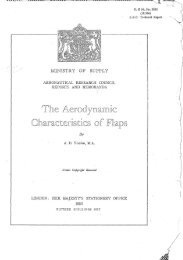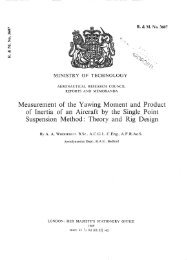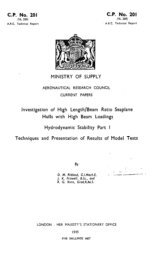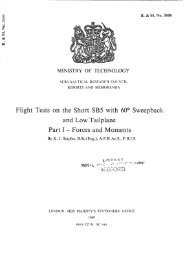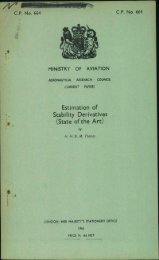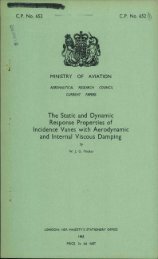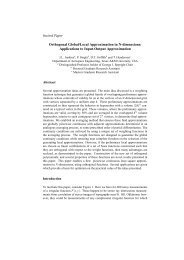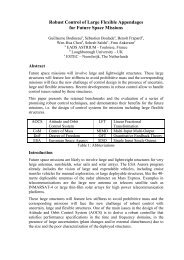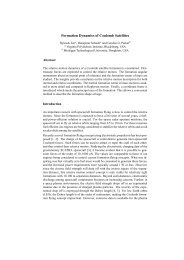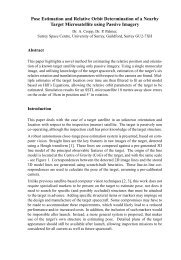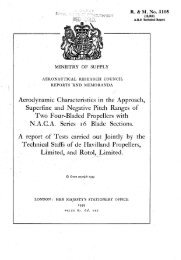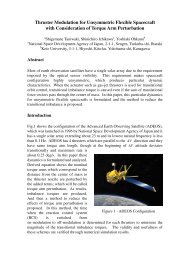A Survey of Unsteady Hypersonic Flow Problems
A Survey of Unsteady Hypersonic Flow Problems
A Survey of Unsteady Hypersonic Flow Problems
You also want an ePaper? Increase the reach of your titles
YUMPU automatically turns print PDFs into web optimized ePapers that Google loves.
46 -<br />
APPENDIX IV Review <strong>of</strong> Flutter <strong>of</strong> Kivpersonio Vehicles<br />
Differences between the flutter behaviour <strong>of</strong> vehicles flying at<br />
hypersonic speeds and the behaviour at lower speeds will be due to changes in<br />
the nature <strong>of</strong> the air flow at hypersonic speeds and the changes in the<br />
stiffnesses Of the vehicle structure which result from heating <strong>of</strong> the structure.<br />
This report is mainly concerned with the effects <strong>of</strong> changes in the nature <strong>of</strong><br />
the flow but the importance <strong>of</strong> the second factor should be borne in mind and<br />
is illustrated in a general way by Fig. 35(a), (b) and (c) from Ref. 55.<br />
In Fig. %(o) the lower line represents the value <strong>of</strong> the speed parameter U/&o,<br />
along the flight pr<strong>of</strong>ile, and the upper line represents the values <strong>of</strong> U/bw,<br />
at which flutter could occur. Its importance is emphasised by the fact that<br />
for sMne flight pr<strong>of</strong>iles the maximum heating rate can be combined with the<br />
maXimum ValUe <strong>of</strong> dynamic pressure on the trajectory - as in the case <strong>of</strong> the<br />
SUperCirOdar lifting re-entry trajectory shown in Fig. 4.<br />
4.1 Types <strong>of</strong> Flutter and Values <strong>of</strong> Flutter Frequency Parameter<br />
The types <strong>of</strong> flutter than can tse expected on hypersonic vehicles are<br />
discussed in Refs. 5 and 6. These discussions and the conclusions presented<br />
here can, <strong>of</strong> course, only be deductions from the likely structures <strong>of</strong> the<br />
vehicles based on general technical considerations. On this basis, flutter<br />
involving vibration modes <strong>of</strong> the main structure IS likely to be met only on<br />
slender vehicles for hypersonic cruise, and lifting re-entry vehicles having<br />
high L/D and, if it occurs,<br />
it seems likely to be <strong>of</strong> a form involving the<br />
longitudinal bending modes <strong>of</strong> the body, even for the winged vehicles. The<br />
slenderness <strong>of</strong> the wing, and the degree <strong>of</strong> integration <strong>of</strong> wing and body, make<br />
it unlikely that vibration <strong>of</strong> the ting can be considered in isolation from the<br />
response <strong>of</strong> the body. Simple bending-torsion flutter could occur for certain<br />
types <strong>of</strong> control surface. Panel flutter could occur on lifting surfaces, heat<br />
shields, and in inlet and propulsion ducts for power units, where panels are<br />
heavily loaded, aerodynamically and thermally. Membrane flutter and large<br />
amplitude distortions could be met if lightweight structures are used to give<br />
lift or drag in re-entry. It is suggested in Ref. 12 that, for slender bodies,<br />
using representative values <strong>of</strong> the overall structural frequencies, an upper<br />
limit <strong>of</strong> 3000 rad.ft/seo can be set on the product wb where w = %f, b is<br />
a representative length and f is a frequency, so that at M = 5,<br />
UC 5000 ft/sec, the maximum value <strong>of</strong> frequency parameter will be about 0.6,<br />
but values are likely to be much lower than this in most practical cases.<br />
For bending-torsion flutter <strong>of</strong> control surfaces it seems likely,<br />
again using representative frequencies, that the maximum value <strong>of</strong> ob will be<br />
around 600 rad.ft/sec, giving maximum frequency parameters around O-1. And, in<br />
a similar way, it can be deduced for panel flutter that frequency parameters<br />
based on a representative length <strong>of</strong> the order <strong>of</strong> the wavelength <strong>of</strong> the panel<br />
mode, will be in the range <strong>of</strong> values up to 0.5.<br />
4.2 Flutter Investigations<br />
Most <strong>of</strong> the reports <strong>of</strong> analytical and experimental work on flutter<br />
at hypersonic speeds that have been published have been concerned with the<br />
standard basic ease <strong>of</strong> flutter <strong>of</strong> a two-dimensional section with pitching and<br />
plunging flexibilities, or the closely comparable case <strong>of</strong> flutter <strong>of</strong> a rigid<br />
half sing with root flexibility in pitching and plunging or flapping, both <strong>of</strong><br />
which are related to the bending/torsion flutter Of wings. There has been a<br />
much smaller amount <strong>of</strong> work on flutter <strong>of</strong> low aspect ratio wings with chordwisebending<br />
as well as torsional and spanwise-bending modes <strong>of</strong> vibration, and with<br />
flutter/



